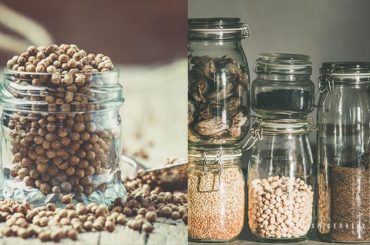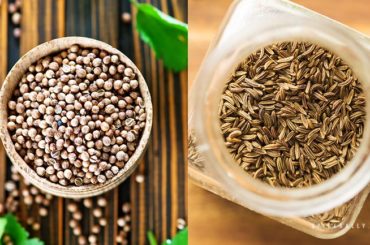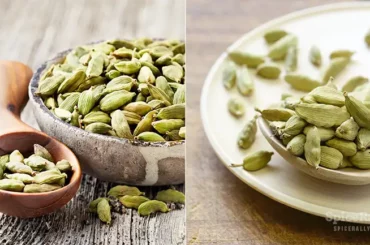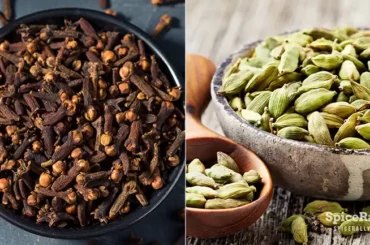Anyone who hears the word allspice would obviously have some weird thoughts about many spices or anything about spices as a cluster. But, while in reality, one small berry will come to the frame and ruin all your strange imaginations! So, if allspice is not about many spices, what is it really?
Allspice is nothing but one single spice deriving from the allspice tree (Pimenta dioica). It features extensively in many sweet and savory dishes, seasonings, and spice blends across the world.
So this article hopes to cover a broad area, including everything you need to know about this wonderful spice. You might have had many doubts about what this spice really is, as to how to incorporate this with cooking, and what other benefits you could get by consuming this spice. But, don’t worry. Because, this time, you have hit the right place as we have answers for everything!
What Allspice Actually Is?
At a glance or as soon as you hear the name of the spice, you might be thinking about many spices or a mixture of several spices. But, allspice is, in fact, a berry from a plant. To be more precise, it is the unripened dried fruit of the allspice tree (Pimenta dioica).
Allspice is also called Myrtle pepper, Jamaican pepper, Pimenta, or Pimento. The allspice plant is known to be native to the Western Caribbean, Southern Mexico, Greater Antilles, and Central America. However, it is best grown in Jamaica. And by now, this crop is being cultivated in many parts of the words as a mid-canopy tree.

Three parts of this plant are used in cooking- the dried allspice berries, leaves, and the wood of this tree. Berries and leaves involve indirect cooking, while wood is used to smoke meat or fish as a fragrant fuel for most traditional barbecue making.
This spice has gained popularity in the culinary world mainly because of its unique and intricate flavor profile. It is said to have a combination of flavors of cinnamon, nutmeg, and cloves with a peppery note of black pepper. And, their look is very similar to black pepper at a glance, while the leaves resemble bay leaves big time.
How Did It Get Its Name “Allspice”?
Allspice is actually the most confusing flavoring in the world of spices, thanks to its name! But as we explained on top, it is just one single spice. However, we cannot say that this spice is nothing like its name suggests.
When the Spanish found this berry, they have thought this was black pepper and called it Pimento, which is why this is also called that way. But, when the English found this, first they called it “newspice”. Then eventually, they understood that the flavor structure of this spice contains all the flavor elements of three main spices.
Therefore, since it tastes like cinnamon, nutmeg, cloves, and black pepper, English started to call this spice “Allspice”. This aspect has made this spice an “all-in-one” ingredient that is protean in many diverse culinary and cultural recipes that are both savory and sweet. While it is still Pimento or Pimenta to the Spanish, this has also become world-famous from its unique name “Allspice”.
However, there are clashing statements as to the chronology of the name allspice. But it is known that its history runs back to at least the 1680s. Some folks say that it is owed to the comprehensive assortment of dishes in which it can be used. In the meantime, some indicate that it is because its taste and smell are similar to a combination of cinnamon, nutmeg, and cloves.
Why Does It Taste Like Cinnamon, Cloves, And Nutmeg?
If you are someone who has never tasted this spice before, if you get a bit into an allspice berry, it will be really smashing. You will get the taste of cinnamon, cloves, nutmeg, and hints of black pepper- all at once. But what is the reason for this berry to get this wonderful flavor?
This may sound a bit scientific, but it is just simple chemistry that you all could understand. Allspice has the flavor elements of cinnamon, cloves, and nutmeg mainly because it contains similar plant or chemical compounds to these three spices.
For example, the essential oil of allspice has Eugenol that can be found in both cinnamon and cloves. And, it also contains phenolic compounds such as polyphenols and flavonoids, just as in nutmeg. Thus, this is the scientific yet, impressive reason for allspice to have the flavor combination of cinnamon, cloves, and nutmeg.
In addition, we said that this flavoring also has hints of black pepper. So, what do you think the reason is? Well, just as in the other three spices, the chemical compounds in both the plats are responsible for this too. Allspice berries contain and leaves contain Myrcene, just as in black pepper. Therefore, it has notes of black pepper too.
A Brief Flashback At The History Of Allspice…
Like its name, allspice also has an interesting backstory. This spice was first remarked by Columbus on his second expedition to the West Indies. But it did not take off in Europe until the seventeenth century.
Apparently, it seems that Sephardic Jewish refugees residing in Santiago de la Vega (Spanish Town) and Port Royal in Jamaica exported allspice to other Jewish traders living in Old World ports. They shipped this spice to places like Venice, Genoa, Constantinople, Amsterdam, and London.
The English called it “newspice” when it reached London. And eventually, it became its most extreme client in the Old World. They used it in pickling brines for vegetables and other seasoning stews.
Key Uses Of Allspice- From History To Modern Era
Allspice has a history like all other spices. People, especially from Caribbean regions, have used this spice in flavoring foods and for various medicinal purposes as folk medicine.
However, at present, this spice is primarily included in cooking. The dried allspice berries are used in a number of spice blends, seasonings, curries, other savory dishes, sweet treats, and baked goods.
At the same time, the leaves of this tree are employed in Indian dishes as a substitute for bay leaves featuring primarily in biryani rice pots. And, we hope to discuss about the culinary use of allspice berries and leaves later in this article.
In addition to the culinary use, allspice essential oil is known to be involved in various other commercial industries. They are:
- Perfumery and other cosmetic manufacturing like aftershaves
- Used in oral hygienic products such as mouthwash and toothpaste
- Chocolate making
- Liquor and other beverage production
- In aromatherapy
In addition, young woody shoots of allspice are commonly assembled into walking sticks and umbrella handles. And, the wood of this tree is used as an aromatic fuel to smoke meat in barbecues.
The leaves, berries, and essential oil in this spice are marked for their excellent and scientifically proven health benefits. Just like the good olden days, this flavoring is still used for pharmaceutical purposes and works as a folk medicine powerhouse.
Culinary Use Of Dried Allspice Berries And Allspice Leaves
If you get allspice already in your spice cabinet, it is like you’ve got three or four flavorings in just one single berry! You know why we say this. Allspice is indeed a unique spice. And its ability to flavor and aromatize your meals should never be underestimated. Believe it or not, that was the most prominent thing that we learned throughout our extensive research on this spice.
Allspice is used both as whole berries and in the ground form. But, both forms call for different recipes. The whole allspice berry is small, round, and dark brown in color. It closely resembles the look of a black peppercorn but not withered looking or darker as black pepper. Ground allspice is usually tan or light brown in color with a texture as in ground coriander.
It is extensively used in Caribbean cuisine and also popular among the Middle Eastern, Arab, and some parts of Europe. It has now eventually moved towards the US cuisine and seemed to be spreading its flavor into the other parts of the world like Asia.
We know you are enthusiastic about learning more about using allspice in your cooking. Just click here, and we will take you to a fully detailed article.
How To Use Allspice Berries, Ground Allspice, And Allspice Leaves In Cooking?
Allspice berries feature many sweet and savory dishes, spice blends, and seasonings. And, a tiny amount of this spice can really go a long way in your dish.
Whole Allspice Berries In Cooking
Whole allspice berries are used abundantly in slow-cooked stews, pickles, mulling, and braises. It pairs well with vegetables and fruits like:
- Beetroots
- Onions
- Cauliflower
- Sweet potatoes
- Cucumbers
- Green beans
- Squash
- Apples
And, allspice teams up with other spices, herbs, and other flavorings like:
- Cinnamon
- Ginger
- Nutmeg
- Cloves
- Black pepper
- Chilli powder
- Cumin
- Coriander
- Garlic powder
- Paprika
- Rosemary
- Thyme
- Lime juice
- Vinegar
This spice is a staple in Jamaican jerk seasonings, pastes, and spice rubs. Whole allspice berries are often used in slow-cooked stews, mulling, braises and pickles.
It also adds a flavorful, aromatic touch to hot rum toddies, mulled apple cider vinegar, and spiced red wine. When allspice berries are blended with cinnamon sticks and orange slices, your beverages will taste heavenly!
Their unique essences mixed together, heavy and heady in the small room. Basil and cinnamon and allspice combined with those elements with no names. Somehow it all worked, all fit exactly right. And the result rivaled the most delicious meals, the most luxurious perfumes, the deep heady richness of the forest. It was perfect
Kat Simons
This flavoring also complements meat dishes very well. Tomatoes, onions combine with allspice, and beef to make tasty Cincinnati Chili. These chili dishes make lovely couples with spaghetti and meatballs. Brining liquids that allspice is included brings the perfect flavorsome juiciness to big cuts of meat like whole chickens, turkey, or pork roasts.
Ground allspice is much intense in flavor than whole allspice thanks to its grinding process. It complements savory dishes as well as sweet dishes and baked goods, taking their taste to the next level. Sweet baked goods like gingerbread, pumpkin cake, spiced cakes, pumpkin pie due to their versatility in blending with the batters.
Ground Allspice In Cooking
Ground allspice is also employed in molasses cookies and in baked custard. Fruit pies become scrumptious when this spice is added. And it has the ability to counterbalance the sweetness of the fruits included in the pies. Go ahead and try a pinch or two in your homemade jams and sweet chutneys to give a tang of warmth, flavor, and aroma.
As mentioned before, this spice is a must-have in many stews, spice blends, and meat in Caribbean cuisine. Jamaican jerk seasoning is the most popular spice blend that allspice features. When blended with ground cinnamon, ground nutmeg, powdered cloves, and ginger powder, allspice become a perfect flavoring in many fruit cakes, winter puddings, Christmas puddings, and gingerbreads. And in Greek cuisine ground, allspice is incorporated with a number of marinades and to season tomato sauce.
Furthermore, ground allspice can also be sprinkled on top of your bowl of yogurt, oatmeal, or cup of coffee for added flavor. Try a pinch even with your hot chocolate or iced coffee to enhance the flavor.
Allspice Leaves In Cooking
Allspice leaves are not used as extensively as whole berries or ground allspice. But still, these leaves add flavor to many dishes in ways you don’t think. In South India, allspice leaves are used as an alternative for bay leaves. And, in fact, they have a close resemblance to the appearance and flavor to that of bay leaves. In ancient times, The Aztecs and Mayans have used the allspice leaf extract as an embalming agent and to spice their beverages.
Moreover, in Caribbean cuisine, the leaves of this spice are used in a number of soups, sauces, stews, and for smoking meat. In addition, these leaves are rich in Eugenol, which is a natural antiseptic and a digestive aid. Consequently, the leaf extract is utilized as a flavoring agent in meat, candies, chewing gums, and even in mouthwashes and kinds of toothpaste.
Some Popular Recipes With Allspice
Savory Recipes
- Jerk Chicken Wings
- Oven-roasted Bratwurst With Apple, Croutons and Sage
- Shrimp Stew With Allspice
- Savory Sausage Pie
- Spice-rubbed Pork Tenderloin
- Spiced Rhubarb Sauce
Sweet Recipes
- Allspice Spice Cake
- Chocolate Allspice Dessert Nachos
- Allspice Streusel Muffins
- Allspice Panna Cotta
- Coconut Allspice Corn Pudding
- Candied Yams
Beverage Recipes With Allspice
- Allspice Dram
- Mulled Wine
- Hot Apple Cider Vinegar
- Jamaican Sorrel Drink
- Lion’s Tale Cocktail
- Rum Hot Toddy
Popular Allspice Seasonings and Spice Blends
- Pumpkin Pie Spice Mix
- Jamaican Jerk Seasoning
- Lebanese Spice Blend
- British Mixed Spice Mix
- Moroccan Slice Blend
- Apple Pie Spice Mix
- Jamaican Mixed Spice For Baking
Flavor Profile
Allspice has an intricate flavor profile. And, it is warm, sweet, and slightly earthy. The flavor is a combination of cinnamon, cloves, and nutmeg tastes with a hint of peppery note as in black pepper.
Its flavor intensifies when powdered. Accordingly, ground allspice has a more warm and intense taste than whole allspice berries.
Fragrance Profile
One thing to be loud and clear, allspice smells really, really good! It is, in fact, has an aroma similar to its taste. That is, it smells earthy, fresh, and has a fragrance combination of cinnamon, cloves, nutmeg, and pepper. When powdered, just like its taste, the smell of ground allspice also intensifies.
Availability
Allspice is available both ground and as whole dried berries. A 1.25-ounce container of whole spice costs around $5 in the USA, while a 0.9-ounce container of ground allspice costs about $4.
This spice is cost-effective and is widely available in leading supermarkets, online shopping sites, and simply from your local grocer.
What Are The Things That You Should Be Concerned About When Buying And Storing This Spice?
Storing your spices properly is essential to extend the shelf-life and preserve the natural flavor and aroma of your spice. And, make sure to check with the manufactured date and expiry date each time you replace your batch of allspice.
Just like any other spice, this flavoring, too, won’t go bad. But if you don’t store them properly once brought home from the store, allspice berries will lose their flavor and aroma shortly than you expected.
However, ground allspice tends to lose its flavor and aroma sooner than whole berries. And, if you are not a commercial chef or someone who does not use allspice regularly, buying whole berries in small batches would be your best bet.
In addition, if any of your recipes call for ground allspice, we suggest you get your whole berries powdered for the moment. When you follow this particular method, you can get the perfect flavor touch and aroma into your meals.
So, returning to storing, always make sure to keep away the whole berries and ground allspice in an air-tight glass container in a cool, dry, dark place.
When stored this way, whole berries will stay flavorful and aromatic for up to three to four years. At the same time, ground allspice will last well for up to two to three years.
Furthermore, the allspice leaves are best used fresh since they tend to lose flavor and scent when dried. Accordingly, fresh leaves will stay nice and crisp for up to two to three days when refrigerated.
What Are The Substitutes For Allspice?
If you ever think of being a pro in cooking, it is crucial that you know about all the possible alternatives or substitutes if you ever run out of one ingredient in your kitchen. Fortunately, you will have plenty of other options to use in place of allspice, despite the nuanced flavor and aroma profiles it has.
You actually cannot expect to have the exact flavor of the original spice from the substitutes. But interestingly, you will not have to think about that much when you use the replacements for allspice. The reason for this is that it has a number of flavor notes from three other main spices in the culinary world.
Thus, try these ingredients in place of allspice in your recipes. They might not have the exact taste, but they can give a very similar flavor to the original spice. These substitutes include:
- Cinnamon
- Nutmeg
- Cloves
- A blend of cinnamon, cloves, and nutmeg (We have a complete article for this ultimate allspice seasoning, click here to learn all the facts)
- Pumpkin Pie Spice Mix
- Apple Pie Spice blend
- Chinese Five-Spice Mix
If you are interested in learning everything about the options you can use in place of allspice, just tap here, and we will take you to the 7 best allspice substitutes!
Health Benefits of Allspice
If you think that this spice is only exceptional in its flavor and aroma, then you have been mistaken. Just like most of the precious spices would have, allspice is also rich in nutrients, and it offers plenty of health benefits.
In fact, the whole berries, leaves, and essential oil in this spice contain nutrient-dense natural plant compounds like Eugenol, Gallic acid, Quercetin, and Ericifolin. And these plant compounds are abundant in antioxidants. In addition, they include the following properties that have a direct impact on the human body. They are:
- Antibacterial effect
- Antifungal properties
- Cancer-fighting properties
- Anti-inflammatory effects
- Anti-proliferative effects
- Apoptosis properties
- Anesthetic properties
- Antiseptic effects
Moreover, this spice also has been used as folk medicine since ancient days. The sources show that the water extracted from the allspice berries is utilized to treat flatulence and diarrhea. At the same time, the pulverized fruit is used as a medication for rheumatism, corns, and neuralgia.
This spice is also popular among the Turkish. And, they usually use allspice with bee honey as an aphrodisiac to boost their sexual activities. Plus, Indians also employ this spice as a fragrant stimulant in digestive issues as an adjuvant to laxatives and tonics. And they make use of the berries of this tree as a painkiller against neuralgia and rheumatism.
In addition to the above-mentioned health benefits, allspice could also be advantageous to your health in many other ways. They include:
- Relieving menopausal symptoms
- Treating oral-related health conditions
- Boosting metabolism and keeping you energetic
- Helping with brain function and mental health issues
- Containing hypotensive effects
To learn about all the health benefits that you get by consuming allspice, click here for a comprehensively detailed article.
Conclusion – Before Terminating The Delectable Spice Story Of Allspice…
By the inception of our feature, we know that you had tons of questions and doubts regarding our wonder spice- allspice. As we unwrapped throughout our intensive article, allspice is not a flavoring that should be underrated by any means! In fact, it has an incredibly distinctive flavor and aroma profile with miraculous health benefits.
Starting from the traditional Jamaican Jerk Seasoning, it could go a long way in your food journals flavoring an uncountable number of savory and sweet dishes. The whole allspice berries, its ground form, and leaves – all can be the best cooking companions whenever you need to try something unique and innovative for your family and loved ones!




